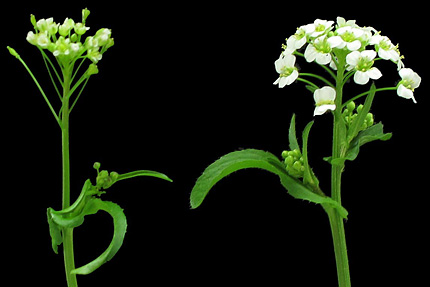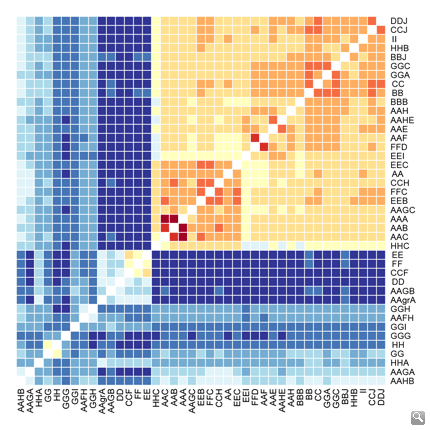Starting from scratch: adaptation to variable environments after an extreme bottleneck
Project code: WE 2897/4-1

Inflorescences from the self-fertilizing Capsella rubella (left) and the outcrossing ancestor Capsella grandiflora (right)
While new species are usually formed through a gradual evolutionary process, they can also arise almost instantaneously, through events that involve severe genetic bottlenecking and loss of variability. Despite a very narrow genetic basis, such species can be remarkably successful. An important question is therefore how they manage to diversify and adapt to new habitats. We aim to address this problem by studying two very young plant species that underwent such bottlenecks: Arabidopsis suecica is in the same genus as the model plant Arabidopsis thaliana and originated as an interspecific hybrid between A. thaliana and A. arenosa. Capsella rubella, which belongs to a genus that is closely related to Arabidopsis, arose as a self-fertilizing form of an outcrossing ancestor. We use modern sequencing technologies to elucidate the patterns of variability in these species, both at the level of genomic DNA polymorphisms and in the transcribed portion of the genome, and compare it to the ancestral species. In addition, we perform functional and fitness studies. Taken together, our data will allow us to address important questions related to the evolutionary role of selfing and allopolyploidy.
Whole genome resequencing of Capsella rubella individuals from throughout the range of the species identifies different populations based on overall genetic distance (lighter: more closely related; darker: more distantly related).
Publications related to the project
- Slotte T, Hazzouri KM, Ågren JA, Koenig D, Maumus F, Guo YL, Steige K, Platts AE, Escobar JS, Newman LK, Wang W, Mandáková T, Vello E, Smith LM, Henz SR, Steffen J, Takuno S, Brandvain Y, Coop G, Andolfatto P, Hu TT, Blanchette M, Clark RM, Quesneville H, Nordborg M, Gaut BS, Lysak MA, Jenkins J, Grimwood J, Chapman J, Prochnik S, Shu S, Rokhsar D, Schmutz J, Weigel D, Wright SI. (2013) The Capsella rubella genome and the genomic consequences of rapid mating system evolution. Nat Genet. 2013 Jul;45(7):831-5.


- Guo YL, Todesco M, Hagmann J, Das S, Weigel D. (2012) Independent FLC mutations as causes of flowering-time variation in Arabidopsis thaliana and Capsella rubella. Genetics. 2012 Oct;192(2):729-39.


- Guo, Y.-L., Bechsgaard, J. S., Slotte, T., Neuffer, B., Lascoux, M., Weigel, D., and Schierup, M. H. Recent speciation of Capsella rubella from C. grandiflora, associated with loss of self-incompatibility and an extreme bottleneck. Proc. Natl. Acad. Sci. USA 106, 5246-5251 (2009).






